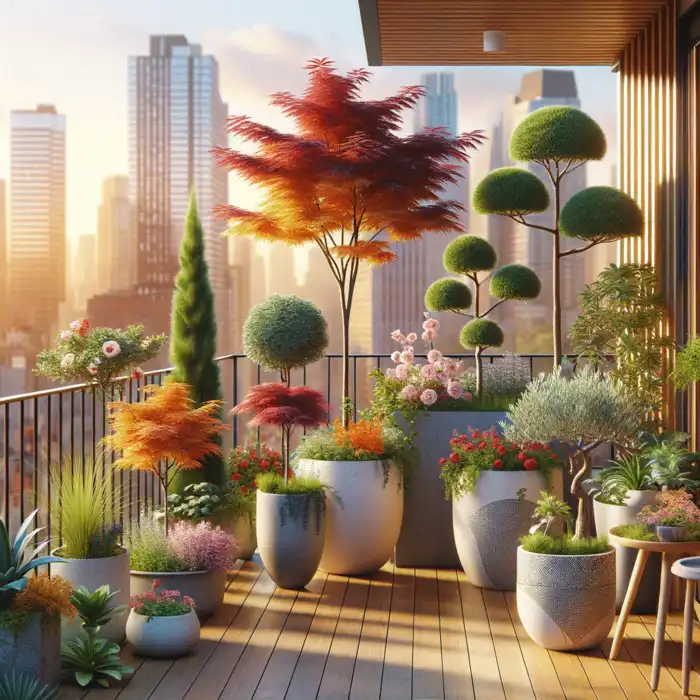Air Quality Improvement
Trees filter pollutants and provide oxygen, essential for our health.
2025-05-10
In an age where urban living often clashes with the desire for greenery, the choice of the right tree species can transform any small space into a vibrant oasis. The journey from barren to blossoming isn't just about aesthetics; it's about creating a healthier environment and enhancing our quality of life.
Compact trees provide numerous advantages in urban settings, enhancing both aesthetics and environmental quality. Explore the key benefits illustrated below.
Trees filter pollutants and provide oxygen, essential for our health.
Roots absorb rainwater, reducing runoff and preventing flooding.
Trees act as natural sound barriers, creating a quieter urban environment.
Spending time near greenery has been shown to reduce stress and enhance mood.
In the hustle and bustle of urban life, finding room for nature can feel like a challenge. That’s where unique tree species come in, specifically designed to thrive in small spaces. At Deep Roots Journal, we understand the delicate balance between urban living and the desire for a green environment. Compact trees not only beautify small gardens but also contribute to biodiversity and improve air quality!
As cities expand, the need for compact trees in urban gardening has grown significantly. These trees can fit into tight spots, adding a touch of nature where traditional trees might not survive. Have you ever thought about how these small trees can enhance your living environment? They provide shade, habitat for wildlife, and can even reduce the urban heat island effect, making your surroundings more comfortable.
Before we delve deeper, let's address some common questions:
Urban gardening is becoming increasingly popular, especially among those with limited outdoor space. Compact trees are the perfect solution for individuals looking to create a green oasis in small backyards, patios, or balconies. Think about the joy of planting a tree that not only fits your space but also flourishes in it! Selecting the right trees for your garden is key to a thriving urban landscape.
By integrating compact trees into urban gardens, we can create pockets of greenery that serve as vital ecosystems. These trees can help regulate temperatures in the summer while providing a beautiful aesthetic throughout the seasons. Just take a moment to visualize a small cherry tree blooming in your backyard—how delightful!
Planting trees in small spaces comes with a host of benefits. Not only do they contribute to the beauty of your surroundings, but they also promote a healthier environment. Are you curious about all the perks they offer? Let's break it down!
At Deep Roots Journal, we believe that even the smallest spaces can make a big impact! By planting unique tree species, you’re not just beautifying your immediate environment; you’re contributing to the health of your entire community. So, what tree will you choose for your space? The possibilities are endless, and each choice has the potential to create a lasting legacy of greenery!
Here's a brief recap of the key points discussed so far:
Once you've planted your unique tree species in a small space, the journey is just beginning! Maintaining the health and beauty of your trees is essential for a thriving urban garden. At Deep Roots Journal, I've learned that tailored care can make all the difference. In this section, I'll share essential tips on long-term care and some encouraging stories about successful plantings that can inspire your gardening journey.
Long-term care is crucial for the health of your compact trees. Regular attention can help your trees thrive and maintain their shape, ensuring they remain a beautiful part of your landscape. Here are some key maintenance tips that I've found effective:
Pruning is not just about keeping your trees looking great; it's also vital for their health! Regularly cutting back branches can improve air circulation and sunlight penetration. This is especially important in small spaces where trees might compete for resources. I recommend starting with light pruning, focusing on any dead or crossed branches to maintain a healthy structure.
As you shape your tree, take a moment to step back and observe its overall form. Would a more balanced silhouette enhance its beauty? It’s a great way to connect with your tree while ensuring it continues to thrive!
In urban gardens, pests and diseases can sometimes feel like unwelcome guests. Being proactive about managing these issues is crucial! Regular inspections of your trees can help you catch problems early. To ensure your trees get the best start, consider encouraging healthy root development.
By keeping an eye on your trees and being attentive to their needs, you can create a healthy environment that supports growth and resilience.
Nothing inspires quite like real-life success stories! Seeing how others have transformed small spaces with unique tree species can motivate you to take action in your own garden. Here are some examples I’ve gathered from my experience and community interactions:
Urban gardens can be incredibly diverse, even in small plots! For instance, I recently visited a local community garden that featured Japanese Maples and Flowering Dogwoods. These trees not only added beauty but also created inviting shady spots for visitors. In another case, a rooftop garden showcased dwarf conifers, which thrived beautifully and provided a lush backdrop for potted plants.
Hearing from fellow gardeners can be incredibly uplifting! Many of my readers at Deep Roots Journal have shared their own transformations:
These stories remind us that even the smallest of spaces can hold immense potential for beauty and joy. By choosing the right tree species and providing proper care, you can create your own urban oasis! For essential tips on maintaining the health of your trees, check out our article on essential tree care and landscaping.
Here is a quick recap of the important points discussed in the article:
